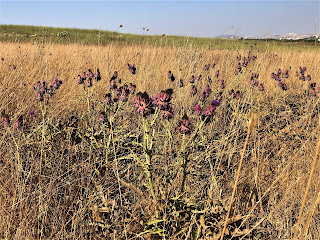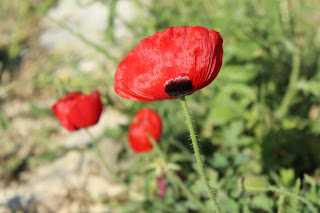November 2021 כסלב תשפ"ב
The last blooming flower of the summer
There is one plant, however, which gives a welcome flash of green and an added ray of sunshine with its yellow flower. You won’t find it in a forest or on a natural hillside as it tends to prefer places where we humans have interfered with the land. The false yellowhead or tayun hadavik in Hebrew grows at the side of roads, old building sites, in the cracks of pavements and alongside dirt tracks. It likes its soil to be bland and without many nutrients so it prefers the meek offerings of a bit of dirt left over after we have finished with it.
Because it pops up in all sorts of cracks and disused areas it would be classified by most people as a weed. However I am part of a growing population of plant lovers that likes to state loudly and insistently that a weed is just a plant growing where it is not wanted. I believe that each ‘weed’ has just as much importance to nature, sustainability, biodiversity, food for animals, pollen for bees and medicinal and beauty properties for humans as the most precious orchid.
Its Hebrew name translates as ‘the sticky clay.’ This is because it favours growing in clay soil and clay in Hebrew is tin, contained in the word tayun. Davik, sticky, is a reference to its leaves which are indeed sticky. These leaves keep many an Israeli schoolchild entertained while out hiking in nature. They love to pick the leaves and stick them on each other declaring that they have given their friend a ‘medal’ in the form of a sticky, smelly green leaf! Unfortunately the invention of dry fit t-shirts has rendered this activity useless. Nothing sticks to dry fit!!
Did you notice that I called it a ‘smelly leaf’? The tayun is indeed very pungent, with a smell I find hard to describe. Just brushing past the plant while walking will release an aromatic, antiseptic, medicinal smell which I deeply dislike. In an interview in Maariv newspaper in 1986 the Poet Yehuda Amichai said of the tayun: “The smell from the tayun is the true smell of the Land of Israel, a little sweet, a little bitter, also dry, also strong and also desperate.”
The tayun is part of the Daisy flower family or also known as the aster, sunflower or officially the compositeae family. Knowing what family a flower comes from can help in identifying it and understanding its character, just like in a human family. In Hebrew it is called the murcavim family, which literally means complicated (I’m sure we all know complicated families!). It has this name because the flower is generally (but not exclusively) made up of two types of flower. You need to look very closely to see the first part. This is normally the flat, middle part of the flower, called the disk in English. In Hebrew, it’s called tzinoriim, which means pipes, because each disk is actually made up of hundreds of tiny pipes. The outer flowers, which look more like traditional petals but are actually individual flowers, are called ray flowers because they resemble the sun’s rays. In Hebrew these are lashoniim which means tongues! The whole flower looks like a yellow daisy. The tayun davik has a cousin called tayunit hacholot and can be found growing in sandy areas, as its name suggests. In English, this is called camphorweed, and its yellow flower is actually much more impressive than the one found inland; the sea of gold adorning Israel’s beaches at the moment is the camphorweed.
The tayun hadavik has been described as a mobile pharmacy. It is said to aid and heal 40 different medical conditions! The juice from the leaves has antibacterial properties and makes a good poultice for a wound. The plant also has anti-inflammatory properties, and it is recommended to put the leaves in a hot bath to ease aching joints. You can steep its leaves in hot water and drink two glasses of this a day to reduce blood pressure. I must confess that as I can’t tolerate the smell, I haven’t been tempted to drink it yet, and it’s hard to imagine ever choosing a brewed, strong-smelling inula leaf over a nice cup of English tea! Despite the smell I still appreciate these little rays of sun on my walks, a nice change from the brown dusty landscape.











































